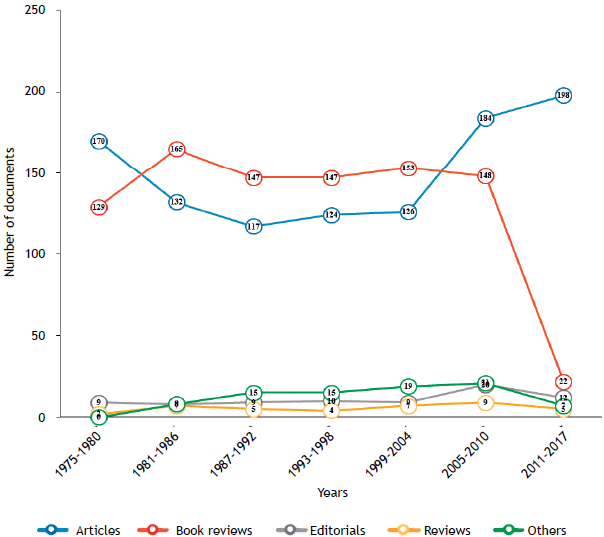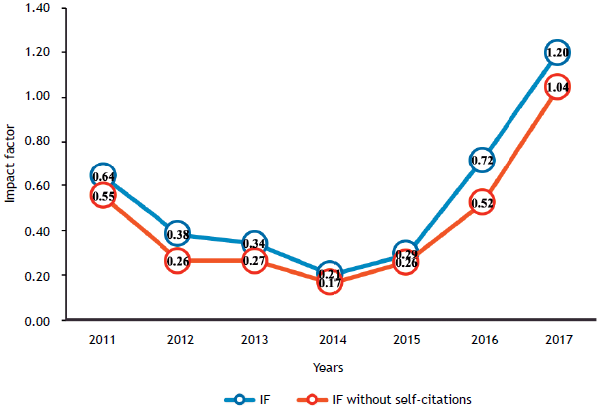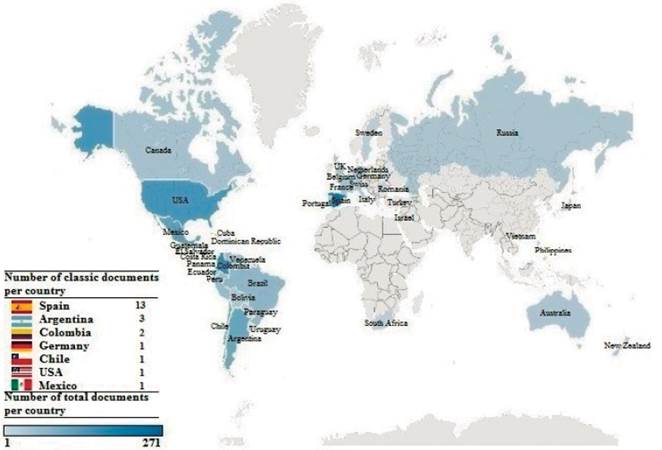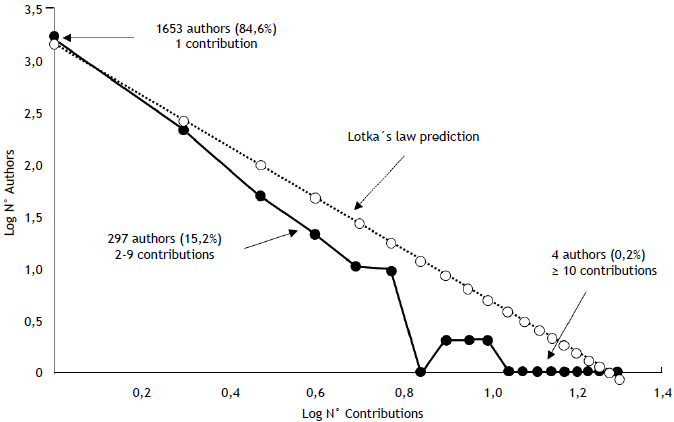Scientific journals are trusted sources for scientific communication, a channel that facilitates the research's knowledge transfer, and a scenario for discussion. As such, journals have presented trends in knowledge produced by singular researchers, research teams, academic communities, institutions, countries, regions, or areas of expertise (Ganga, Paredes, & Pedraja-Renga, 2015; López-López et al., 2018; Navarrete-Cortés, Fernández-López, López-Baena, Quevedo-Blasco, & Buela-Casal, 2010; Pire, 2015; Zych & Buela Casal, 2010). The knowledge gathered in scientific journals can be collected in databases for further varied contents analysis.
The first scientific journals were published in 1665. The first journal was named Le Journal des Scavans, published in Paris, and the second was published in London and called Philosophical Transactions (Banks, 2018). The first scientific psychology journals were also published in Europe at the end of the 19th century. The first of these was the journal Mind, founded in 1876 by Alexander Bain in England at University College London (Harper, 2019; Staley, 2009). Some years after the creation of the Psychology Laboratory in Leipzig, Wilhelm Wundt created Philosophische Studien in 1881 (Bringmann & Ungerer, 1980; Titchener, 1921). In the USA, the first journal was The American Journal of Psychology created in 1887 by Granville Stanley Hall (Fuchs, 2012). In Latin America, the first journals were Brazilian. In 1949, Arquivos Brasileños de Psicología and Boletim de Psicología of Sao Paulo were established, and Boletim de Psicología of Rio de Janeiro was created two years later (Ardila, 1986). In Colombia, the first journal was Revista de Psicología, founded in 1956 by Mateo Mankeliunas at the Universidad Nacional de Colombia in Bogotá (Ossa & Cudina, 2016).
The journals have played diverse roles in the region because they have contributed to consolidating the discipline in the continent, which has the highest number of psychologists, training programmes, and psychology students in the world. The journals have helped to train psychologists and visualise knowledge from this region and from the world; this is clear as they have been included in several databases. Redalyc includes more than ninety psychology journals from Ibero America through the Ibero American Federation of Associations of Psychology (FIAP, for its acronym in Spanish) portal, Scopus includes forty Latin American journals, and WoS includes about ten (López-López, 2018).
The history of Psychology journals has recently been studied in Argentina (Visca, Gallegos, López-López, Polanco & Cervigni, 2018), Chile (Polanco-Carrasco, Gallegos, Salas & López-López, 2017), and Colombia (Acevedo-Triana et al., 2018; Ávila-Toscano, Marenco-Escuderos & Madariaga, 2013; Cudina & Ossa, 2016). These studies and other similar ones are all relevant for the development of psychology in the respective countries.
Scientific psychology journals have been analysed primarily by bibliometric methods in several countries. Studies have used bibliometric indicators and metrics to analyse the evolution of journals from when they were created to the present day or for a certain period of time. Some of these studies have analysed journals from one country in particular such as the USA (Allik, 2013; Milfont & Page, 2013; Tur-Porcar, Mas-Tur, Merigo, Roig-Tierno & Watt, 2018), Spain (Rodríguez & Arbinaga, 2018; Tortosa-Pérez, Osca-Lluch, López-López & Alfaro-Ferreres, 2019), Brazil (Fradkin, 2017), Chile (Sáez-Ibañez et al., 2019; Salas et al., 2017), and Colombia (Aguado-López, Becerril-García & Aguilar-Bustamante, 2016; Aguilar-Bustamante & Aguado-López, 2018; Morgado-Gallardo et al., 2018; Ravelo, Mejía & González, 2016; Salas et al., 2018). Other studies have aimed to analyse psychology journals from a regional perspective such as Ibero America (Franco-Suárez & Quevedo-Blasco, 2017; López-López, de Moya Anegón, Acevedo-Triana, Garcia & Silva, 2015) or a worldwide perspective (García-Martínez, Guerrero-Bote & Moya-Anegón, 2012).
Within the scientific Latin America psychology journals, the Revista Latinoamericana de Psicología (henceforth RLP, for its acronym in Spanish), ISSN: 01200534, has been an important referent because it is the second oldest psychology journal in Latin America (founded in 1969) indexed to Scopus. The oldest journal in the region is Revista Interamericana de Psicología, which began publishing two years previously (Polanco, Béria, & Klappenbach, 2017). The first RLP issue was published in 1969 in Colombia; the founder was Rubén Ardila, an outstanding Latin American psychologist (Gallegos, 2017). Ever since it first started publishing, this journal has been an important channel for psychology in Colombia and Latin America (Klappenbach, Vásquez-Ferrero & Gallegos, 2018). It has played a crucial role, and continues to do so, in the creation of scientific psychology communities, particularly in Colombia (Ardila, 2013). Previous studies have analysed this journal with historical (Gallegos, 2010; Gutiérrez, Pérez-Acosta & Plata-Caviedes, 2009) and bibliometric emphasis (Gómez-Morales, Jaraba-Barrios, Guerrero-Castro & López-López, 2012; López-López & Calvache, 1998; Zych & Buela-Casal, 2009). They have demonstrated that the RLP has had a great influence on Latin American and Ibero American psychology.
The RLP is currently indexed on the following databases: Social Sciences Citation Index and Current Contents/Social and Behavioral Sciences -Web of Science- [WoS], Clarivate Analytics, Scopus, Redalyc, SciELO, and Biological Abstracts (Millán, Cudina & Ossa, 2017). The RLP has transitioned from a paid subscription to open access model: authors pay fees once their articles are accepted for publication.
Metrics have made different types of measurements visible that evaluate the impact of articles, and the RLP is no exception. The metrics of this journal for 2017 in the Scimago Journal & Country Rank showed that it was positioned in Quartile 1 (Q1) for social sciences (miscellaneous) and Quartile 3 (Q3) for psychology (miscellaneous). Additionally, the journal has increased its average prestige per article (Scimago Journal Rank, SJR2017 = 0.299) as well as its contextual citation impact by weighting the number of citations based on the total number of citations in a subject field in which the journal is indexed (Source Normalized Impact per Paper, SNIP2017 = 0.786).
The current article aims to analyse the difference between the RLP and the WoS journal indicators as the former was the first, and, for many years, it has been the only journal in this area in Colombia and Latin America. In order to achieve this, we conducted a bibliometric study to generally describe the sample of documents, characterise those documents, and then carry out an in-depth analysis of the classic RLP articles.
Method
The sample was taken from the Core Collection of Web of Science (WoS), updated January 22, 2018. The period began in 1975, when the RLP was first listed in WoS, until 2017. Given that Volume 3 of Issue 50 (corresponding to 2018) had not yet been indexed, 2018 is not included in this study. Thus, the sample included 2,163 documents.
In order to build a dataset, we used Microsoft Excel 2016 to integrate the records from the automatic tools (standardised and then manually corrected), and the records were then obtained using the SciMAT programme (Cobo, Lopez-Herrera, Herrera-Viedma & Herrera, 2012). The nine articles indexed as proceeding papers were classified as articles to avoid duplication. The articles that had an English and Scottish affiliation were classified as having been written in the UK (Chiu & Ho, 2005); whereas those articles from the Federal Republic of Germany, the German Democratic Republic, and Germany were recorded as publications from Germany (Ho, 2012). Articles from the Soviet Union and Russia were categorised as records from Russia (Ho, Siu, & Chuang, 2016). Records from Columbia and Colombia were re-classified as being from Colombia after the affiliations had been checked.
The sample of documents was analysed following three consecutive stages: (1) Description of the general sample of documents; (2) Characteristics of the articles; and (3) Identification of the most cited articles.
The first stage involved describing each document in terms of the type of document, year, language, number of authors, and journal's Impact Factor (IF) based on the Journal Citation Reports (JCR), and the H-index (Hirsch, 2005). During the following stage, the analysis included author productivity and their countries of affiliation, impact, keywords (of the author and assigned by WoS), the most cited authors and journals where those references were published, and the main authors and journals that were cited the RLP. In order to analyse author productivity, Lotka's
Law was used as it describes the expected level author contribution according to the number of articles published by each one (Lotka, 1926). The impact was evaluated through the H-index (Hirsch, 2005), the number of journal citations in WoS during the period covered, and TC2 indicator, which considers each article's number of citations in the second and third year after its publication (Li & Ho, 2008).
In the last stage, the most cited articles were identified using H-Classics (Martínez, Herrera, López-Gijón & Herrera-Viedma, 2014). This concept delimits the group of most cited articles and considers the relationship between the number of citations and the value of the H-index (Hirsch, 2005). The impact was evaluated using the TCyear indicator, which considers the citations accumulated until a given year; and the Cyear indicator, which records the citations obtained in a given year: in this case, 2017 (Ho & Hartley, 2016). Furthermore, the number of years between publication and the first recorded citation was calculated as was the type of methodology used; this discriminated between theoretical (classic and meta-analysis), quantitative, and qualitative articles (Montero & León, 2007).
Results
General description of the documents
Of the 2,163 documents published in the RLP, there were five types of documents identified: Articles (1,051: 48.6%), book reviews (911: 42.1%), editorials (77: 3.6%), reviews (39: 1.8%), and other documents, such as biographies, corrections of published papers, and software reviews (85: 4.0%). The majority of the documents were written in Spanish (1,997: 91.8%), followed by English (164: 7.54°%). Other languages used were Portuguese (9: 0.37%), French (4: 0.18%), and German (3: 0.14%).
The number of publications per year and type of document varied. As shown in Figure 1, the number of articles published has increased in recent years, but the number of book reviews published has decreased during the same period. This trend clearly contrasts with the period between 1981 and 2004, when book reviews were more commonly published than articles. During the whole period, the number of editorials, reviews, and other types of documents has remained stable in relation to the total number of published documents.
In total, 1,954 authors contributed to writing documents. The authors with the most contributions were Rubén Ardila (twenty documents) and Alba Mustaca (17 documents). In terms of book reviews, 419 authors published this type of document, and Rubén Ardila (71 documents) and Jaime González Yepes (seventy documents) were the authors who contributed the most to this category of publication. Ninety authors wrote reviews. Ana Adán, Rubén Ardila, Ramón León, and Andrés Pérez-Acosta authored two documents each, which was the highest number of contributions to the section.
The visibility of the RLP progressively increased in the last period evaluated (Figure 2), and it reached its pinnacle in 2017. Of the five types of documents published, articles have shown to have the highest impact (H-index = 21), followed by reviews (H-index = 7).
Characteristics of the articles
The type of documents classified under "article" have been continuously published since 1975: ranging from 17 (in 1988, 1997, and 2002), to 43 article (in 2012). From 2012 onwards, articles have been the most frequently published documents each year (Figure 1). The majority of were written in Spanish (984 articles: 93.6%), followed by English (64: 6.1%), and German, French, and Portuguese (one document each: 0.1%).
The authors of the articles had affiliations with thirty countries. Spain had the highest number of publications, 271, representing 23.6% of the total number of publications. Latin American countries (Argentina, Brazil, Bolivia, Chile, Costa Rica, Colombia, Cuba, Ecuador, El Salvador, Guatemala, Mexico, Panama, Paraguay, Peru, the Dominican Republic, Uruguay, and Venezuela) contributed 634 articles, representing 55.2% of the total amount of publications. The seven major industrialized countries (G7: Canada, France, Germany, Italy, Japan, the UK, and the USA) contributed 204 articles, which corresponded to 17.8% of the total articles (see Figure 3).
Lotka's Law was also evaluated in relation to the scientific production of the authors who have published in the RLP. The logarithmic function of the number of authors in relation to their number of contributions is displayed in Figure 4, which presents and compares the values it is expected will be observed. In terms of the observed values, 84.6% of the authors who have published in the journal have only contributed with one publication (as either a principal author or co-author), and 10.49% have contributed two publications; only 4.91% have contributed three or more publications.
Based on the visual representation, the observed distribution did not adjust to Lotka's Law (Lotka, 1926). Although the figure showed a high number of authors with just a few publications, and very few authors with a larger number of contributions, there was a large distance between the observed and expected values. Thus, the journal's general production is majorly diverse in terms of author contributions.
The keywords (KW) used in the articles differed depending on whether they were selected by the authors (KWA) or assigned during the WoS indexation process (Keywords Plus, KW+) (Garfield & Sher, 1993). In total, 3,373 KW were used in the articles, ranging from zero to 21 (adding together both KWA and KW+). The most frequently used KW were related to behaviour (115 KW corresponding to 181 articles), psychology (53 KW corresponding to 114 articles), cognitive (37 KW corresponding to 98 documents), and social aspects (66 KW corresponding to 92 articles).
As shown in Table 1, the references used in the RLP (13,495 in total) show the influence of renowned authors of the field, such as Burrhus Skinner and Albert Bandura, as well as Latin American authors, such as Rubén Ardila (Florez, 2003) and Rogelio Díaz-Guerrero (Alarcón, 2010). The journals with the highest number of articles cited were mainly from the USA (70.3%): 53.3% were affiliated with the American Psychological Association. Journals from the UK represented 13.3%, and those from Colombia and Spain 6.6% for each country.
Table 1 The 15 most cited authors and journals in the Revista Latinoamericana de Psicología.
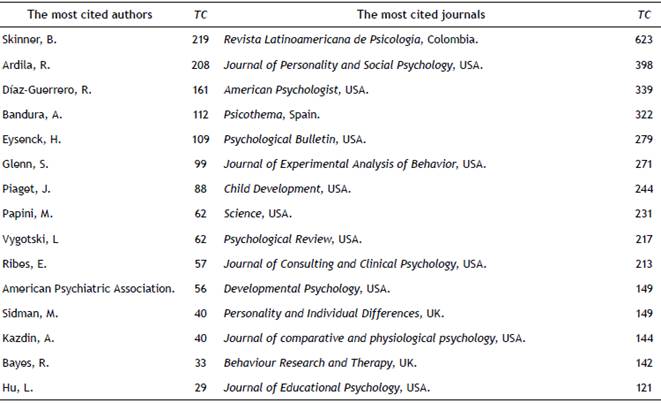
Note. TC = Total citations.
One-thousand-and-fifty-one articles from the RLP were cited 1,749 times in the WoS Core Collections. The authors who provided the most citations to the RLP were Gualberto Buela-Casal and Rocío García-Retamero. Table 2 shows that Universitas Psychologica contributes the most citations to the RLP (96 citations); it is followed by Psicothema (45 citations) and Revista Mexicana de Psicología (43 citations). It is also important to highlight the RLP's international contribution given that six Spanish journals were among the main citing journals (40%). This was followed by the USA and Mexico (13.3% each); and then Chile, the UK, and Switzerland (6.6% each).
Table 2 Main 15 authors and journals citing the Revista Latinoamericana de Psicología.
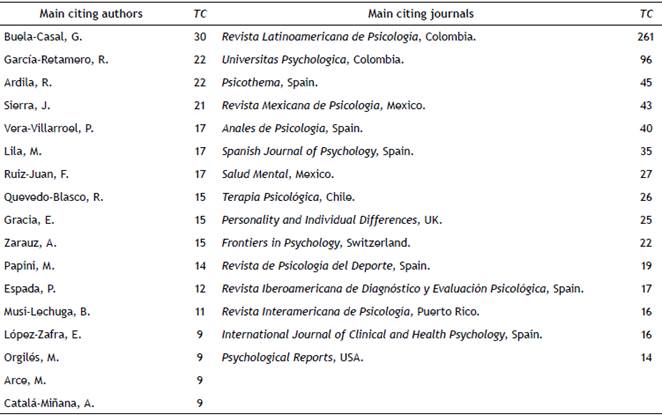
Note. TC = Total citations.
It is noteworthy that the RLP has been cited by journals with a very high impact factor such as Personality and Individual Differences (25 citations), Frontiers in Psychology (22 citations), and Psychological Reports (14 citations). The ratio between references and citations differed in each case: the RLP was referred 2.4 times more than the times that it was citied; Personality and Individual Differences, 5.7 times more; and Psicothema, 7.8 times more. The relation between references and citations between these journals and the RLP was quite uneven.
Classic articles
A journal's classic articles are the documents that are cited many times (Garfield, 1977). According to the definition of H-Classics (Martínez et al., 2014), classic articles can be defined in terms of the H-index of that field: 21 for the RLP.
In total, the RLP had 22 classic articles published between 1976 and 2016, and, as shown in Table 3, there was a 27.45 average total citation. These articles were written mainly in Spanish (20: 90.9%) and in English (2: 9.1%) by 65 authors, 36 male (55.4%) and 29 female (44.6%), and the number of authors ranged from one to seven. Sixty-three authors contributed once, and only two authors contributed twice: Enrique Gracia and Juan Herrero. The majority of the principal authors (14: 63.6%) and the corresponding authors (13: 59.1%) were males.
Table 3 The most cited articles in the Revista Latinoamericana de Psicología.
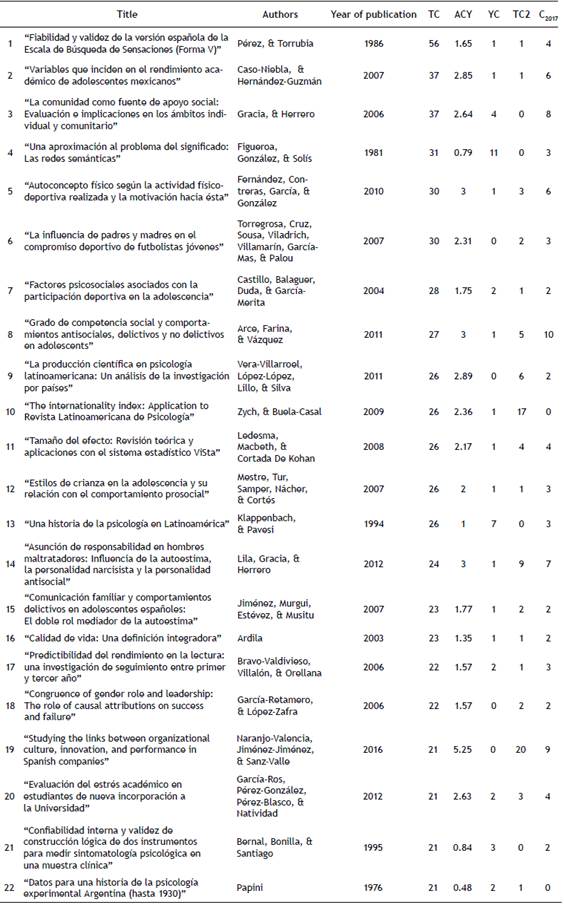
Note. TC= total citations; ACY= average number of citations per year; YC= years between publication and first citation; TC2= total citations received in the first two years after publication; C2017= total citations received in 2017.
As shown in Figure 3, the classic articles represented contributions with affiliations to seven countries. Spain led the way with 59.1% of these contributions, and a further 31.8% were from Latin America: from countries such as Argentina (three articles), Colombia (two articles), and Chile and Mexico (one article each). Of the total number of classic articles, 20 (90.9%) were written in collaboration, which included 16 national and four international collaborations.
In terms of the methods, quantitative design was primarily used (18 articles: 81.8%), followed by theoretical design (4 articles: 18.2%). Qualitative methods were not used in any classic articles. Quantitative classic articles were published between 1981 and 2016 by an average of 3.3 authors whereas the theoretical classic articles were published between 1976 and 2008 by an average of 1.75 authors.
Of the 22 classic articles, six had a C2017 over 5. These articles have remained current in terms of their impact (Ho & Hartley, 2016). The article "Grado de competencia social y comportamientos antisociales, delictivos y no delictivos en adolescentes" was awarded a ten, achieving the highest C2017 (Arce, Fariña & Vázquez, 2011). This article established an escalating relationship between social incompetence and antisocial and criminal behaviours, contributing to the understanding of youth violence and supporting the implementation of multimodal interventions for this young population.
"Studying the links between organizational culture, innovation, and performance in Spanish companies" (Naranjo-Valencia, Jiménez-Jiménez & Sanz-Valle, 2016) (C2017= 9), reported empirical research about the role of the type of organisational culture to facilitate or act as a barrier for performance and innovation and as a mediator between culture and performance.
The article "La comunidad como fuente de apoyo social: Evaluación e implicaciones en los ámbitos individual y comunitario" (Gracia & Herrero, 2006) (C2017= 8) presented three complementary studies and reached the conclusion that the perception of community support was influenced by the conditions of the community within the residence and positively associated with psychological adjustment.
"Asunción de responsabilidad en hombres maltratadores: Influencia de la autoestima, la personalidad narcisista y la personalidad antisocial" (Lila, Gracia, & Herrero, 2012) (C2017=7), provided further evidence for the role low self-esteem has on minimising the violent acts for which the subjects were convicted.
"Variables que inciden en el rendimiento académico de adolescentes mexicanos" (Caso-Niebla & Hernández-Guzmán, 2007) (C2017=6), concluded that motivation, study skills, and substance use influenced academic performance. Differences for each sex were also reported to be part of those variables.
Lastly, the article "Autoconcepto físico según la actividad físicodeportiva realizada y la motivación hacia ésta" (Fernández, Contreras, García & Villora, 2010) (C2017=6), linked body dissatisfaction to physical attractiveness in female teenagers.
All the classic articles showing C2017 > 5 were written using quantitative methods. Eighty-two percent of the authors (14) were affiliated with Spain, 12% (2) with Mexico, and 6% (1) with Colombia.
Discussion
The RLP has certainly become one of the most important psychology journals in Latin America due to its history and impact. This journal has stood the test of time and achieved remarkable improvements in the different aspects evaluated in scientific journals (Gallegos, 2010). When the journal celebrated its thirtieth anniversary, its founder highlighted RLP's longevity, given that the majority of Latin American scientific journals only manages a maximum of ten issues before completely disappearing (Ardila, 1998).
Although the RLP was conceptualised from the beginning as an editorial platform for Latin America (Lopez-Lopez & Calvache, 1998), it has been expanding and consolidating as a referent in Ibero America over the years. This has been supported by the fact that its publications were affiliated with countries from this region and there were six Spanish journals among its 15 main citing journals. Some exceptions to this trend were journals from other regions, such as Personality and Individual Differences (UK), Frontiers in Psychology (Switzerland), and Psychological Reports (USA).
Book reviews have been an important channel of communication in social sciences and humanities but quite unusual in natural sciences (Liu, Ding & Gu, 2017). Since the creation of the RLP, these reviews have been a distinguishing mark on the journal and have contributed to the dissemination of those reviewed books. Given that the current study aimed to provide general perspective about the bibliometric evolution of the RLP, it was not possible to gather reliable information to identify if those reviews have led to an increase in the number of citations of those reviewed books, which was suggested by Gorraiz, Gumpenberger, and Purnell (2014). However, book reviews significantly decreased between 2011-2017, which has been reported as a current trend in psychology publications (Hartley & Ho, 2017). The RLP has not been an exception.
However, the journal can still explore further areas. Some initiatives may involve the stability of the technological platform and focus on the visibility of the articles and authors in line with the Dora declaration and the Leiden Manifesto. These have promoted the number of indicators per article and allowed major visibility together with higher researcher responsibility. Further promotion strategies for the journal may also involve academic social networks and ALMetrics indicators (Lopez-Lopez, 2019).
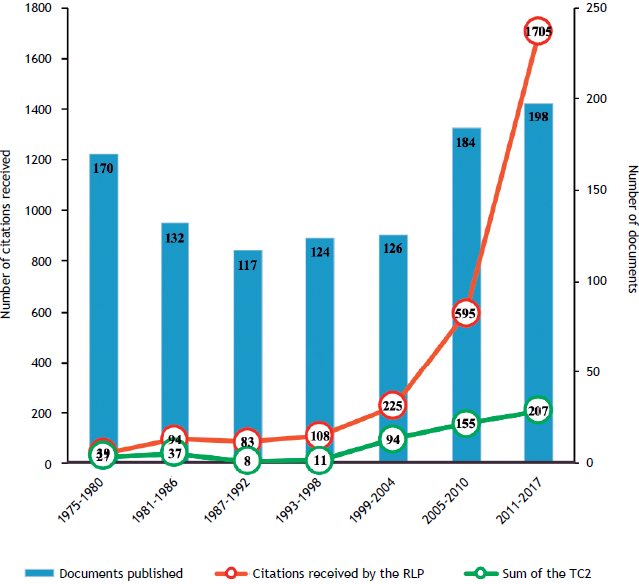
Figure 5 Number of documents published, total citations received per year, and total number of citations in the first two years after publication (TC2) in the Revista Latinoamericana de Psicología.
Given that the majority of the published documents and classic articles were written in Spanish, authors using languages other than Spanish may be prevented from accessing this knowledge. Thus, one recommendation would be to publish journal articles with versions in Spanish and English: a bilingual journal; which is a strategy that some Spanish journals have been already successfully implementing. We also recommend that the historical contents of the journal could be accessible on the same journal's website rather than only being available in Redalyc, which currently stores the first issues that were edited fifty years ago.
Over time, the RLP has consolidated its recognition as a journal with an international focus, that is Open Access, and has a progressive increase in its impact factor. Thus, the journal has an excellent opportunity to visualise new opportunities for further development, including the previously described use of ALMetrics (Orduña-Malea, Martín-Martín & Delgado-López, 2016; Salas, 2017).
The majority of the classic articles were written by research teams. Thus, there is an additional incentive for national and international collaborations as a specific strategy to contribute to the field more significantly. This growing trend has also been identified in other journals in the region (Aguado-López, López-López, Becerril-García & Salas, 2017; Morgado-Gallardo et al., 2018; Polanco, Béria & Klappenbach, 2017; Salas et al., 2017; Cudina, Millán & Ossa, 2017), which reveals a clear possibility for further development as high-impact scientific research is created by teams. Furthermore, publications including authors affiliated to different countries have shown a larger number of citations (Narin, Stevens & Whitlow, 1991), which, in turn, have made the journal more versatile.
Future research could provide an updated bibliometric analysis of the RLP based on areas of expertise and methodologies that have previously been conducted (López-López & Calvache, 1998) or a study about the references used (Bapte, 2017). Thus, this body of research would contribute with up-to-date information regarding the development of research in the region.
The RLP is a significant psychology referent in Latin America as well as within the wider Spanish-speaking community. Its fiftieth birthday marks a significant milestone for Colombia and the region, and the studies it publishes contribute to the advancement of this discipline.













